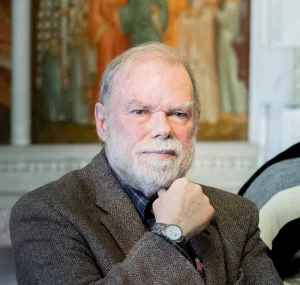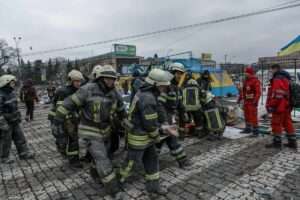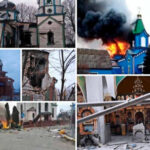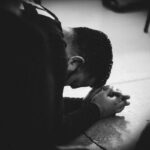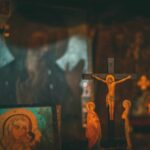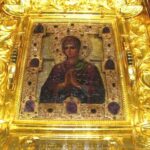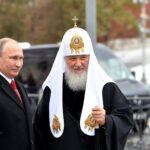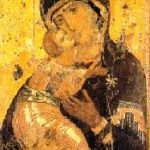Pascha in Dachau
Dachau concentration camp, opened 22 March 1933, was the first Nazi concentration camp in Germany. Over 200,000 prisoners from more than 30 countries were held there during the years of the Third Reich, of whom two-thirds were political prisoners and nearly one-third Jews.
by Gleb Alexandrovitch Rahr
Dachau, April 27, 1945: The last transport of prisoners arrives from Buchenwald. Of the 5,000 originally destined for Dachau, I was among the 1,300 who survived the trip. Many were shot, some starved to death, others died of typhus.
April 28: I and my fellow prisoners can hear the bombardment of Munich taking place. As the sound of artillery approaches ever nearer, orders are given proscribing prisoners from leaving their barracks. SS-soldiers patrol the camp on motorcycles as machine guns are directed at us from the watch-towers.
April 29: The booming sound of artillery has been joined by the staccato bursts of machine gun fire. Shells whistle over the camp from all directions. Suddenly white flags appear on the towers, a sign that the SS would surrender rather than shoot all prisoners and fight to the last man. At about 6:00 p.m., a strange sound can be detected emanating from somewhere near the camp gate which swiftly increases in volume. Finally all 32,600 prisoners join in the cry as the first American soldiers appear just behind the wire fence of the camp.
After the electric power is turned off, the gates open and the American GIs make their entrance. As they stare wide-eyed at our lot, half-starved and suffering from typhus and dysentery, they appear more like fifteen-year-old boys than battle-weary soldiers...
An international committee of prisoners is formed to take over the administration of the camp. Food from SS-stores is put at the disposal of the camp kitchen. A US military unit also contributes provisions – my first taste of American corn. By order of an American officer, radio receivers are confiscated from "prominent Nazis" in the town and distributed to the prisoners. The news comes in: Hitler has committed suicide, the Russians have taken Berlin, and German troops have surrendered in the South and in the North.
Naturally, I was ever cognizant of the fact that these momentous events were unfolding during Holy Week. But how could we mark it other than through our silent, individual prayers? A fellow prisoner and chief interpreter of the international prisoner's committee, Boris F., paid a visit to my typhus-infested barracks, Block 27 to inform me that efforts were underway, in conjunction with the Yugoslav and Greek National Prisoner's Committees, to arrange an Orthodox service for Easter, May 6th.
Among the prisoners there were Orthodox priests, deacons and monks from Mount Athos. But there were no vestments, no books, no icons, no candles, no prosphoras, no wine. Efforts to acquire all these items from the Russian parish in Munich failed, as the Americans could not locate anyone from that parish in the devastated city.
Nevertheless, some of the problems could be solved. The approximately 400 Catholic priests detained in Dachau had been allowed to remain together in one barrack and say mass every morning before going to work. They offered us Orthodox the use of their prayer room in Block 26. The chapel was bare, save for a wooden table and an icon of the Theotokos hanging above the table.
A creative solution to the problem of the vestments was also found. New linen towels were taken from the hospital of our former SS-guards. When sewn together lengthwise, two towels formed an epitrachilion and when sewn together at the ends they became an orarion. Red crosses, originally intended to be worn by the medical personnel of the SS-guards, were put on the towel-vestments.
On Easter Sunday, May 6, Serbs, Greeks and Russians gathered at the Catholic priests' barrack. Although Russians comprised about 40 percent of the Dachau inmates, only a few managed to attend the service. By then "repatriation officers" of the special "Smersh" units had arrived in Dachau by American military planes, and began the process of erecting new lines of barbed wire for the purpose of isolating Soviet citizens from the rest of the prisoners – the first step in preparing them for their eventual forced repatriation.
In the entire history of the Orthodox Church there has probably never been an Easter service like the one at Dachau in 1945. Greek and Serbian priests together with a Serbian deacon wore the make-shift vestments over their blue and gray-striped prisoners uniforms. Then they began to chant, changing from Greek to Slavonic, then back to Greek. The Easter Canon, the Easter Sticheras – everything was recited from memory. The Gospel – "In the beginning was the Word" – also from memory. The Homily of St. John Chrysostom also from memory. A young Greek monk from the Holy Mountain stood up in front of us and recited it with such infectious enthusiasm that we shall never forget him as long as we live. St. John Chrysostomos himself seemed to speak through him to us and to the rest of the world as well!
Eighteen Orthodox priests and a deacon, most of them Serbs, participated in this unforgettable service. Like the sick man who had been lowered through the roof of a house and placed in front of the feet of Christ the Savior, the Greek Archimandrite Meletios was carried on a stretcher into the chapel, where he remained prostrate throughout the service.
The priests who participated in the 1945 Dachau Easter service are commemorated at every Divine Service held in the Dachau Russian Orthodox Memorial Chapel, along with all Orthodox Christians who lost their lives "at this place, or at another place of torture."
Within the Dachau Resurrection Chapel is a large icon depicting angels opening the gates of the Dachau concentration camp and Christ Himself leading the prisoners to freedom.
Should you ever come to Germany, be sure to visit our Russian chapel at Dachau and pray for all those who died "at this place, or at another place of torture."
Khristos voskrese! Christos anesti! Christ has risen!
❖ IN COMMUNION / Pascha/ Spring 2011/ Issue 60

